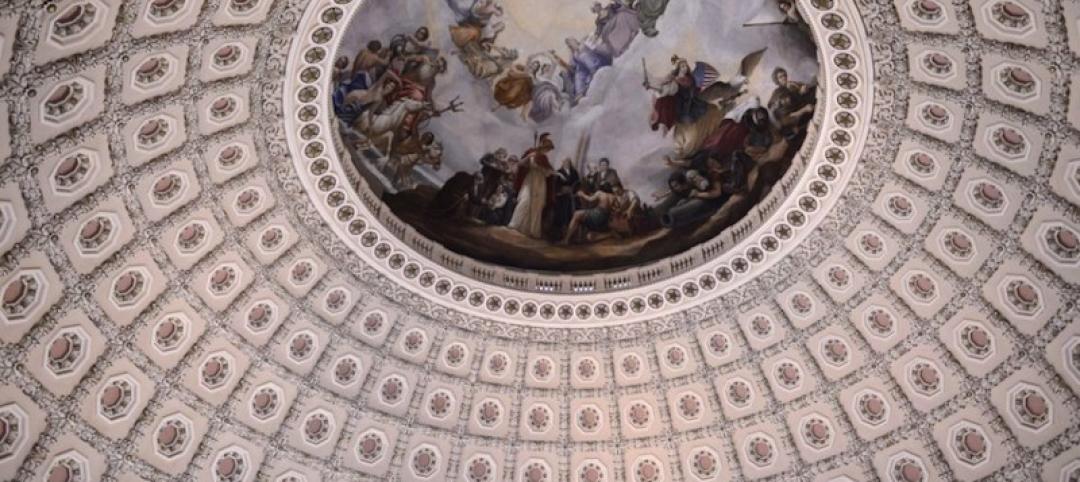At 35 stories, the State Courts Towers at Havelock Square is the tallest government building in Singapore. And while it’s been open since December 2019—when the State Courts started relocating from a nine-story building that dated back to 1975—details and images about its design and construction have only recently been made public by CPG Consultants, the S$450 million (US$334.6 million) project’s Principal Consultant and Architect.
The 178-meter (584-ft) building contains 53 courtrooms and 54 hearing chambers. The structure, designed by Serie + Multiply Consultants, is actually two slender buildings, the Court Tower and Office Tower, connected by 39 link bridges. The design optimizes visibility to the public, with courtroom boxes placed onto large “court trays” of different heights and sizes that are completely open in that there is no glazed façade around the tower.
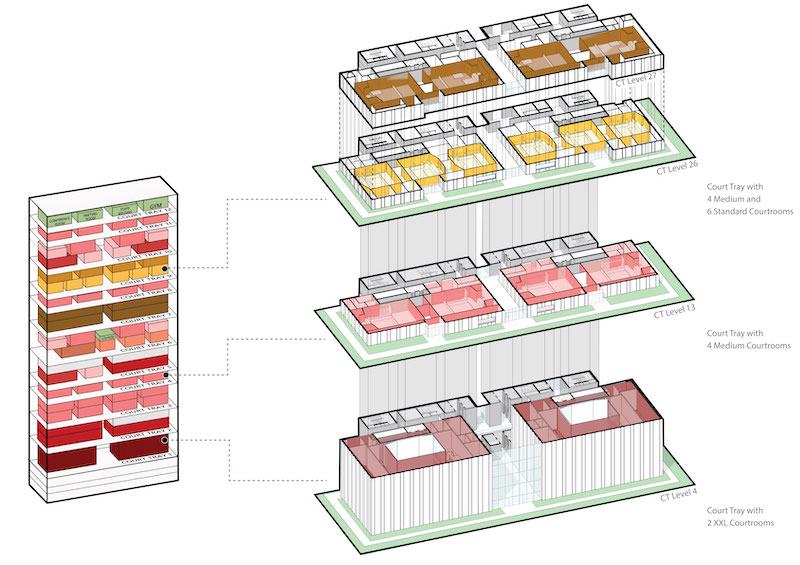
The towers' 53 courtrooms are placed onto “trays” of different sizes that are “open,” in that there's no glazed facade. Illustration: CPG Consultants
Each “tray” includes a garden terrace that filters sunlight and allows for views of the city. The courtrooms themselves are clad in pigmented precast panels, five to 12 meters in height, whose colors and textures match the tiled roofs of shophouses in Singapore’s nearby Chinatown.
“The relationship between the city and its civic buildings was our primary interest for this project,” explains Christopher Lee, Principal at Serie Architects UK. “The new State Courts Towers should be a building that is symbolically open and accessible to the public. Its design language is drawn from the architecture typical of the city and hence is both familiar and surprisingly new to its citizens.”
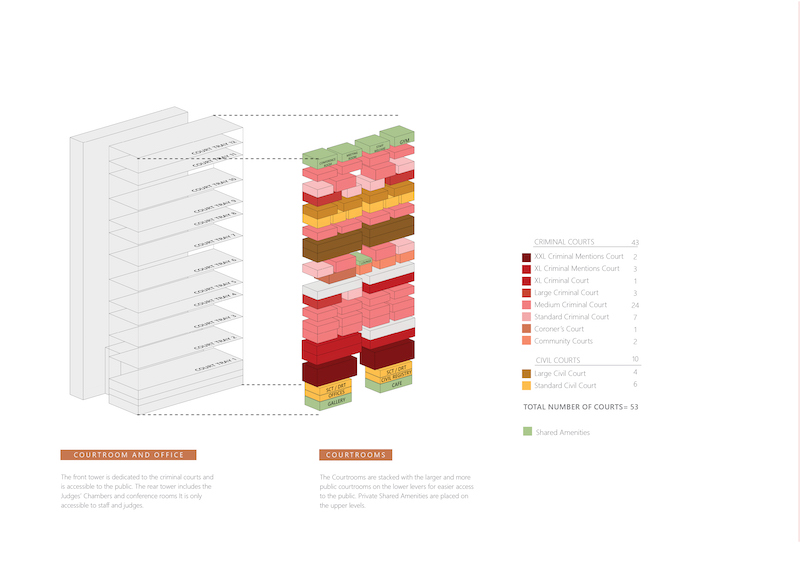
The front tower includes the courtrooms and is accessible to the public; the back tower is for judges' chambers and conference rooms. The towers are linked by 39 bridges. lIlustration: CPG Consultants; Image: Khoogj
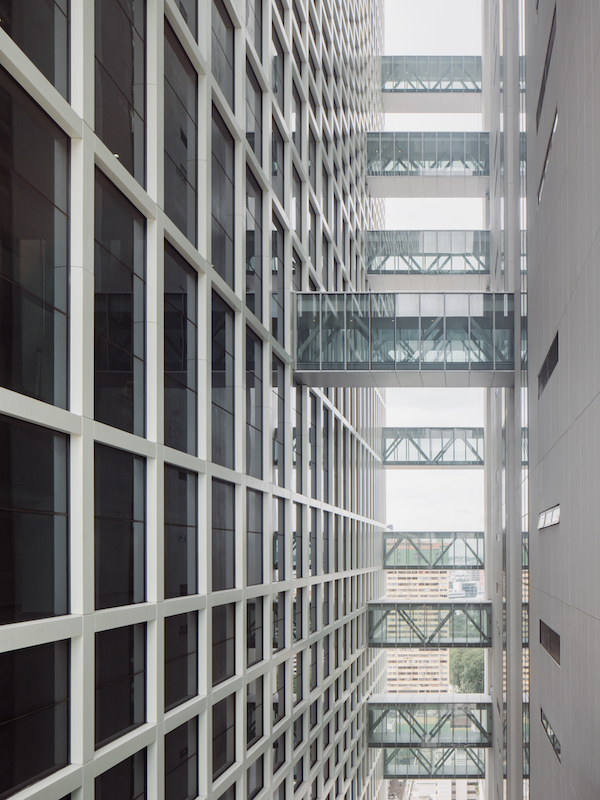
A SMART, TRANSPARENT BUILDING
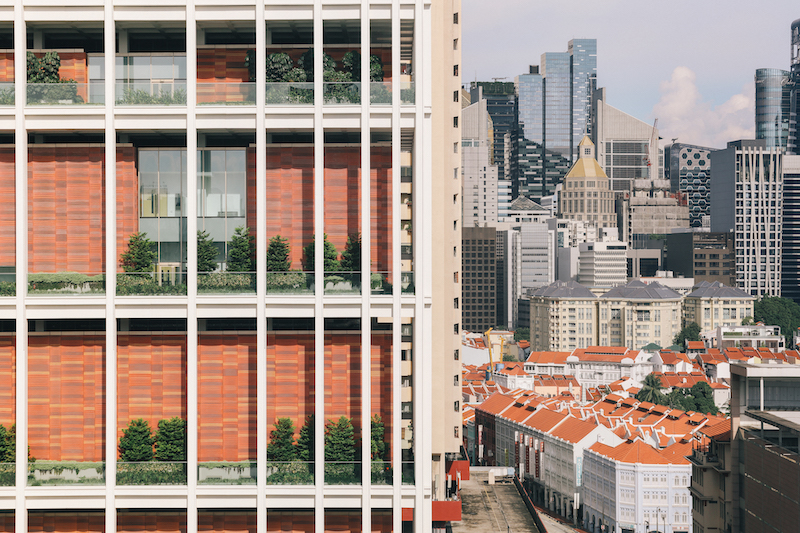
The cladding for the courtrooms is precast panels, 5 to 12 ft in height, whose colors and textures match to roofs of nearby shops in Singapore's Chinatown. Image" Finbarr Fallon
The office tower, for judges’ chambers and staff offices, features a vertical façade that expands where light and views are required in the middle, and contracts where the service core is located. Horizontal grids draw the viewer’s eye across the façade and to the sky.
The towers include a coworking space managed by the Singapore Academy of Law, for attorneys and tech companies; a theatrette, business center, cafeteria, roof garden and sky terraces, and a library and auditorium located in the basement.
The complex’s smart building features include facial recognition and automated building management processes for security and MEP systems. Other IT or web-enabled services introduced include video-conferencing facilities and interactive self-service kiosks. A universal design approach was adopted to ensure that it is user-friendly to the judges, persons in custody, and the public, for example in providing Assistive Listening Systems for court attendees and in all its courtrooms, digital wayfinding through apps.
The State Courts Towers is an environmentally sustainable building, with green building features incorporated in its design, such as solar panels and condensate water recovery systems.

Open space, acoustics, user inclusion, visibility, and smart technology were important factors in the design of the courtrooms. Illustration: CPG Consultants; Image: Khoogj

Related Stories
| Jan 13, 2014
Custom exterior fabricator A. Zahner unveils free façade design software for architects
The web-based tool uses the company's factory floor like "a massive rapid prototype machine,” allowing designers to manipulate designs on the fly based on cost and other factors, according to CEO/President Bill Zahner.
| Jan 11, 2014
Getting to net-zero energy with brick masonry construction [AIA course]
When targeting net-zero energy performance, AEC professionals are advised to tackle energy demand first. This AIA course covers brick masonry's role in reducing energy consumption in buildings.
| Dec 31, 2013
BD+C's top 10 stories of 2013
The world's tallest twisting tower and the rise of augmented reality technology in construction were among the 10 most popular articles posted on Building Design+Construction's website, BDCnetwork.com.
| Dec 27, 2013
U.S. Capitol dome’s cracks to be repaired during $60 million renovation
Rings of scaffolding will start to rise this spring around the cast-iron dome of the U.S. Capitol in Washington as part of a $60 million renovation project to repair more than 1,300 cracks.
| Dec 20, 2013
Can energy hogs still be considered efficient buildings? Yes, say engineers at Buro Happold
A new tool from the engineering firm Buro Happold takes into account both energy and economic performance of buildings for a true measure of efficiency.
| Dec 13, 2013
Safe and sound: 10 solutions for fire and life safety
From a dual fire-CO detector to an aspiration-sensing fire alarm, BD+C editors present a roundup of new fire and life safety products and technologies.
| Dec 10, 2013
16 great solutions for architects, engineers, and contractors
From a crowd-funded smart shovel to a why-didn’t-someone-do-this-sooner scheme for managing traffic in public restrooms, these ideas are noteworthy for creative problem-solving. Here are some of the most intriguing innovations the BD+C community has brought to our attention this year.
| Dec 9, 2013
Skaneateles, N.Y., converts old firehouse to net-zero village hall
The Finger Lakes village of Skaneateles, N.Y., renovated its vacant firehouse into Skaneateles Village Hall, the first municipal net-zero energy building in the state of New York.
| Dec 4, 2013
First look: Dubai's winning bid for World Expo 2020 [slideshow]
Dubai has been chosen as the site of the 2020 World Expo. HOK led the design team that developed the master plan for the Expo, which is expected to draw more than 25 million visitors from October 2020 through April 2021.
| Dec 3, 2013
Architects urge government to reform design-build contracting process
Current federal contracting laws are discouraging talented architects from competing for federal contracts, depriving government and, by inference, taxpayers of the best design expertise available, according to AIA testimony presented today on Capitol Hill.






